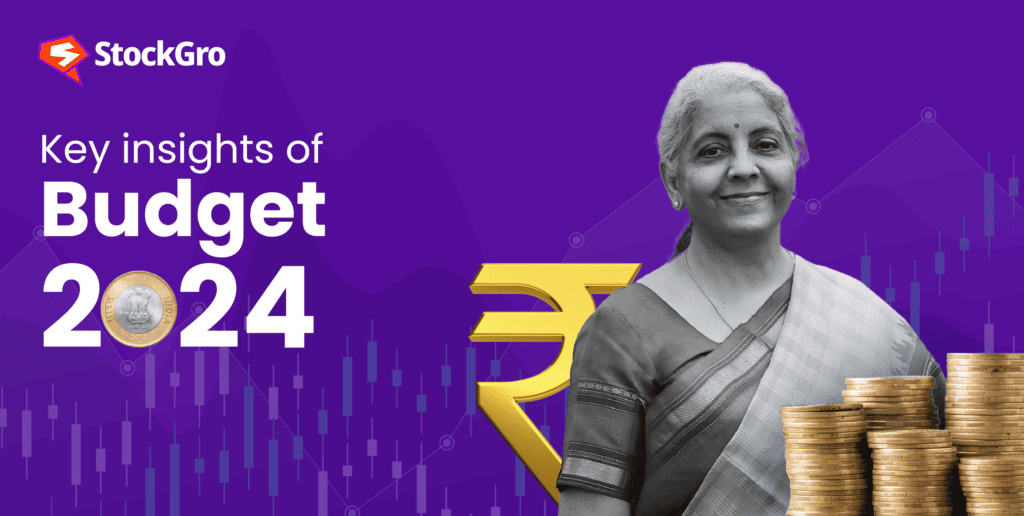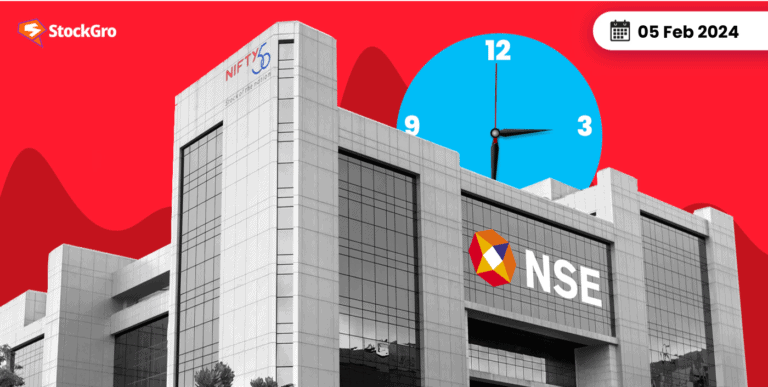
Union Finance Minister Nirmala Sitharaman presented the interim budget ahead of the 2024 Lok Sabha elections, marking the last budget of Prime Minister Narendra Modi’s second term. With a total planned expenditure of ₹47,65,768 crore, of which ₹11,11,111 crore is dedicated to capital expenditure, this budget outlines the government’s financial roadmap for the year ahead. This blog will summarise the key points and budget 2024 impacts.
Also read: Union budget 2024: Expectations you must know
Major figures from the budget 2024
- Plans to bring down the fiscal deficit to 5.1% of GDP in FY25 and less than 4.5% of GDP by FY26.
- Capex’s outlay increased to ₹11.11 lakh crore for 2024-25, up by 11.1%.
- Gross market borrowing is set at ₹14 lakh crore for 2024-25.
- Total expenditure is revised to ₹44 lakh crore for 2023-24.
- Nominal GDP growth is considered at 10.5% for FY25.
- Divestment targets were set at ₹50,000 crore for FY25 and reduced to ₹30,000 crore for FY24.
- The estimated total revenue receipts for FY25 are expected to be ₹30 lakh crore, which is higher than the revised estimate of ₹26.99 lakh crore.
Key focus areas
The budget 2024 focuses on four key areas:
‘Garib’– Poor
- Direct Benefit Transfer (DBT) saved ₹2.7 lakh crore.
- A quarter of a billion individuals have been liberated from multidimensional poverty.
- Additionally, 78 lakh street vendors have credit help through the PM-SVANidhi project, with 2.3 lakh of them receiving support more than once.
‘Yuva’– Youth
- 1.4 crore youth trained under the Skill India Mission, enhancing employability and skill sets.
- PM Mudra Yojana has encouraged youth entrepreneurship with 43 crore loans sanctioned, promoting innovation and self-employment.
‘Annadata’– Farmers
- Direct financial support provided to 11.8 crore farmers under the PM-KISAN scheme, ensuring their financial well-being.
- Crop insurance extended to 4 crore farmers through the PM Fasal Bima Yojana, securing their livelihood against unpredictable risks.
- Integration of 1,361 mandis under eNAM, facilitating a more efficient and transparent agricultural market, supporting a trading volume of ₹3 lakh crore.
‘Mahilayen’– Women
- 30 crore Mudra Yojana loans have been offered to businesswomen to support women-led business entities.
- In a decade, the number of women enrolling in higher education has surged by 28%, with a 43% increase in STEM fields.
- Support for 83 lakh Self-Help Groups (SHGs) to help 1 crore women become Lakhpati Didis which is having an earnings of at least ₹1 lakh a year.
What’s in the income tax union budget?
The union budget 2024 highlights income tax in the following:
- The tax rates for direct and indirect taxes, as well as import duties, remain the same.
- Notably, individuals earning up to ₹7 lakh annually will not incur any tax liability under the new tax regime.
- A few tax breaks for start-ups and investments made by sovereign wealth funds and pension funds. As well as tax exemption for certain International Financial Services Centre (IFSC) units, previously set to expire on 31st March 2024, now extended to 31st March 2025.
- The budget suggests waiving unfulfilled direct tax demands for up to ₹25,000 in requests made before FY10 and up to ₹10,000 in requests made between FY11 and FY15. Approximately one crore taxpayers are anticipated to gain from this move.
You may also like: Old vs. New – Which income tax regime is better for FY 2023-24?
Sector-specific measures
Sustainability
- A number of proposals are put out to achieve “Net Zero” carbon emissions by 2070. Like VGF – viability gap funding in wind energy projects. Also, initiatives for setting up coal gasification and liquefaction capacities. Compressed biogas, PNG, and CNG blending will be made gradually to lessen dependency on fossil fuels. And also, financial assistance will be given to the purchase of biomass aggregation equipment.
- Through a rooftop solarization scheme, each month up to 300 units of free electricity will be available to 1 crore families.
- Promotion of electric buses for public transport to reduce carbon emissions.
- Support for the electric vehicle ecosystem, including manufacturing and charging infrastructure.
- A new biomanufacturing and biofoundry initiative is launched to support environmentally sustainable substitutes.
- The continued distribution of LPG connections under the Pradhan Mantri Ujjwala Yojana (PMUY).
- Under UJALA-Unnat Jyoti Affordable LEDs for All energy-efficient electronics like fans, tube lights, and LED bulbs will be distributed.
- Installation of LED street lights under the Street Lighting National Programme (SLNP) to enhance energy efficiency.
Infrastructure
- As part of the PM Gati Shakti plan, the budget announces the commencement of three significant railway corridor initiatives.
- Push towards promoting foreign investment is outlined, with plans to negotiate bilateral investment treaties.
- The expansion of existing airports and the comprehensive development of new airports are to be undertaken under the UDAN-Ude Desh ka Aam Naagrik scheme.
- The budget highlights a commitment to urban transformation through the promotion of Metro rail projects and the NaMo Bharat scheme.
Health
- Starting a push to get girls between the ages of 9 and 14 to get vaccinated against cervical cancer.
- Speeding up of Saksham Anganwadi and Poshan 2.0 projects to enhance early childhood care, development, and nutrition delivery.
- Launch of the U-WIN platform as part of Mission Indradhanush’s immunisation initiatives.
- Extending health coverage to all ASHA-Accredited Social Health Activists, Anganwadi workers, and Helpers under the Ayushman Bharat scheme.
Housing
- The 3 crore homes that the Pradhan Mantri Awas Yojana (Grameen) set out to build are almost reached; an additional 2 crore homes are to be built over the next five years.
- Introduction of a Housing for Middle-class scheme to assist middle-class families in purchasing or building their own homes.
Tourism
- All the state governments are urged to create distinctive tourism destinations in order to increase trade and stimulate regional entrepreneurship.
- States will be offered long-term interest-free loans to spur tourism development.
- Initiatives to enhance port accessibility, infrastructure for tourism, and amenities on islands like Lakshadweep will be implemented.
Agriculture and food processing
- The government intends to encourage investment in post-harvest operations from both the public and private.
- Nano-Diammonium phosphate, or Nano-DAP, will be applied more widely in all agroclimatic zones.Nano-DAP is a nano-fertiliser that promises to enhance nutrient efficiency, reduce input costs for farmers, and lessen environmental pollution.
- A strategy will be formulated under the Atmanirbhar Oilseeds Abhiyaan to achieve self-reliance in oilseed production.
- The government intends to create an extensive plan for the advancement of dairy farming. This programme will focus on increasing milk production, supporting dairy farmers, and enhancing the quality of dairy products.
- In an effort to increase exports, generate job opportunities, and improve aquaculture output, the government intends to expedite the Pradhan Mantri Matsaya Sampada Yojana.
- To further boost the fisheries sector, the budget proposes the establishment of 5 Integrated Aquaparks.
Also read: Union budget 2024: A deep dive into sectoral expectations
Bottomline
The Nirmala Sitharaman budget speech, for the last time in the current term, sets up a temporary financial foundation. It drives India towards continued economic growth and enhanced social welfare as the nation awaits the formation of a new government post-election.

